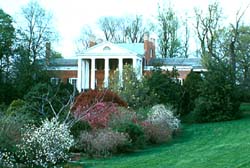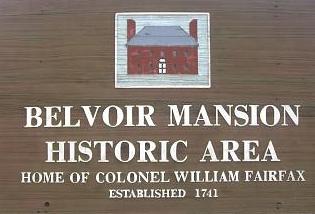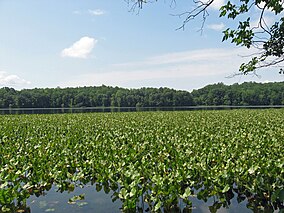
Woodbridge is a census-designated place (CDP) in Prince William County, Virginia, United States, located 20 miles (32 km) south of Washington, D.C. Bounded by the Occoquan and Potomac rivers, Woodbridge had 44,668 residents at the 2020 census.

The Appomattox Court House National Historical Park is the preserved 19th-century village named Appomattox Court House in Appomattox County, Virginia. The village was named for the presence nearby of what is now preserved as the Old Appomattox Court House. The village is the site of the Battle of Appomattox Court House, and contains the McLean House, where the surrender of the Army of Northern Virginia under Robert E. Lee to Union commander Ulysses S. Grant took place on April 9, 1865, an event widely symbolic of the end of the American Civil War. The village itself began as the community of Clover Hill, which was made the county seat of Appomattox County in the 1840s. The village of Appomattox Court House entered a stage of decline after it was bypassed by a railroad in 1854. In 1930, the United States War Department was authorized to erect a monument at the site, and in 1933 the War Department's holdings there was transferred to the National Park Service. The site was greatly enlarged in 1935, and a restoration of the McLean House was planned but was delayed by World War II. In 1949, the restored McLean House was reopened to the public. Several restored buildings, as well as a number of original 19th-century structures are situated at the site.

Oak Hill is a mansion and plantation located in Aldie, Virginia that was for 22 years a home of Founding Father James Monroe, the fifth U.S. President. It is located approximately 9 miles (14 km) south of Leesburg on U.S. Route 15, in an unincorporated area of Loudoun County, Virginia. Its entrance is 10,300 feet (3,100 m) north of Gilberts Corner, the intersection of 15 with U.S. Route 50. It is a National Historic Landmark, but privately owned and not open to the public.

Westover Plantation is a historic colonial tidewater plantation located on the north bank of the James River in Charles City County, Virginia. Established in c. 1730–1750, it is the homestead of the Byrd family of Virginia. State Route 5, a scenic byway, runs east–west to the north of the plantation, connecting the independent cities of Richmond and Williamsburg.

Stratford Hall is a historic house museum near Lerty in Westmoreland County, Virginia. It was the plantation house of four generations of the Lee family of Virginia. Stratford Hall is the boyhood home of two Founding Fathers of the United States and signers of the United States Declaration of Independence, Richard Henry Lee (1732–1794), and Francis Lightfoot Lee (1734–1797). Stratford Hall is also the birthplace of Robert E. Lee (1807–1870), who was General in Chief of the Armies of the Confederate States during the American Civil War (1861–1865). The Stratford Hall estate was designated a National Historic Landmark in 1960, under the care of the National Park Service in the U.S. Department of the Interior.

Manassas National Battlefield Park is a unit of the National Park Service located in Prince William County, Virginia, north of Manassas that preserves the site of two major American Civil War battles: the First Battle of Bull Run, also called the Battle of First Manassas, and the Second Battle of Bull Run or Battle of Second Manassas. It was also where Confederate General Thomas J. Jackson acquired his nickname "Stonewall". The park was established in 1936 and listed on the National Register of Historic Places on October 15, 1966.

Richard Bland Lee was an American planter, jurist, and politician from Fairfax County, Virginia. He was the son of Henry Lee II (1730–1787) of "Leesylvania" and Lucy Grymes (1734–1792), as well as a younger brother of both Maj. Gen. Henry Lee (1756–1818) and of Charles Lee (1758–1815), Attorney General of the United States from 1795 to 1801, who served in both the Washington and Adams administrations.

Woodlawn is a historic house located in Fairfax County, Virginia. Originally a part of Mount Vernon, George Washington's historic plantation estate, it was subdivided in the 19th century by abolitionists to demonstrate the viability of a free labor system. The address is now 9000 Richmond Highway, Alexandria, Virginia, but due to expansion of Fort Belvoir and reconstruction of historic Route 1, access is via Woodlawn Road slightly south of Jeff Todd Way/State Route 235. The house is a designated National Historic Landmark, primarily for its association with the Washington family, but also for the role it played in the historic preservation movement. It is now a museum property owned and managed by the National Trust for Historic Preservation.

Col. Henry Lee II (1730–1787) of was an American planter, soldier, and politician, from Westmoreland and later of Prince William County. Although he served in local military offices as well as state legislative offices before and after the conflict, he may today be best known for Leesylvania plantation in Prince William County, or as the father of several important revolutionary figures, especially, Henry "Light-Horse Harry" Lee III, and grandfather of Robert E. Lee.

Sully Historic Site, is both a Virginia landmark and nationally registered historic place in Chantilly, Virginia.

Westmoreland State Park lies within Westmoreland County, Virginia. The park extends about one and a half miles along the Potomac River and covers 1,321 acres. The Horsehead Cliffs provide visitors with a panoramic view of the Potomac River, and lower levels feature fossils and beach access. The park offers hiking, camping, cabins, fishing, boating and swimming, although mechanical issues have kept the swimming pool closed since 2021. Located on the Northern Neck Peninsula, the park is close to historical sites featuring earlier eras: George Washington's birthplace and Stratford Hall, the birthplace of Robert E. Lee.

Salona, in McLean, Virginia, is a former plantation house on the National Register of Historic Places surrounded by land protected by two conservation easements. The Salona homestead and grounds comprise 7.8 acres (3.2 ha) within the 52.4-acre (21.2 ha) site, and are protected by a 1971 easement held by the Fairfax Board of Supervisors. A much newer conservation easement held by the Northern Virginia Conservation Trust added an additional 41 acres (17 ha), of which 10 acres (4.0 ha) will be placed in active recreational use, and the rest used for passive recreation, such as trails.

Sayler's Creek Battlefield, near Farmville, Virginia, was the site of the Battle of Sayler's Creek of the American Civil War. Confederate general Robert E. Lee's army was retreating from the Richmond to the Petersburg line. Here, on April 6, 1865, Union general Philip Sheridan cut off and beat back about a quarter of Lee's depleted army. Eight Confederate generals surrendered, and 7,700 men were lost. Confederate Major General George Washington Custis Lee, eldest son of Robert E. Lee, was forcibly captured on the battlefield by Private David Dunnels White of the 37th Massachusetts Regiment. The battle was the last major engagement of the war in Virginia; Lee's surrender at Appomattox occurred three days later. A portion of the landmarked battlefield area is included in Sailor's Creek Battlefield Historical State Park. The Civil War Trust and its partners have acquired and preserved 885 acres (3.58 km2) of the battlefield in five transactions since 1996.

Belvoir was the plantation and estate of colonial Virginia's prominent William Fairfax family. Operated with the forced labor of enslaved people, it sat on the west bank of the Potomac River in Fairfax County, Virginia, at the present site of Fort Belvoir. The main house — called Belvoir Manor or Belvoir Mansion — burned in 1783 and was destroyed during the War of 1812. The site has been listed on the National Register of Historic Places since 1973 as "Belvoir Mansion Ruins and the Fairfax Grave."

Historic Blenheim is a c. 1859 brick farm house designed in the Greek Revival style and located in City of Fairfax, Virginia. During the American Civil War, Union soldiers were often encamped on the grounds surrounding the house and utilized it as part of a reserve hospital system. As a result, more than 115 of these soldiers inscribed words and pictures on the first and second floor walls, as well as the attic of the house. Blenheim was added to the National Register of Historic Places in 2001.

The Potts-Fitzhugh House is a historic house at 607 Oronoco Street, Alexandria, Virginia. It served in the early 1800s as the home of Anne Hill Carter Lee and her family, including Robert E. Lee. It should not be confused with the Lee–Fendall House, which is located at 614 Oronoco Street.

Waveland is a historic plantation house and farm located near Marshall, Fauquier County, Virginia in the Carter's Run Rural Historic District. It was individually listed on the National Register of Historic Places in 2004, and the surrounding district listed in 2014.

Freestone Point Confederate Battery is a historic American Civil War gun emplacement located at Leesylvania State Park, Woodbridge, Prince William County, Virginia. The battery has four individual gun emplacements, which are fairly simple in configuration. All are formed by a large, deep, rectangular depression with high earthen berms built up on the north and south side of each depression. Three of the batteries are located on the cliff about 90 feet above the Potomac River. For five months, from October 1861 to March 1862, the batteries contributed to the Confederate military's success in blockading the Potomac River.
The Civil War Trust's Civil War Discovery Trail is a heritage tourism program that links more than 600 U.S. Civil War sites in more than 30 states. The program is one of the White House Millennium Council's sixteen flagship National Millennium Trails. Sites on the trail include battlefields, museums, historic sites, forts and cemeteries.
Leesylvania was a plantation and historic home in Prince William County, Virginia, now part of Leesylvania State Park. During the 18th century, it was the home of Henry Lee II, his family and numerous slaves, and known for its productive land and especially the quality of its tobacco. Lee's sons Henry "Light-Horse Harry" Lee, Richard Bland Lee and Charles Lee, held prominent positions in Virginia during the American Revolutionary War and early federal government.























